The Hottest (Hootie-est?) Hit On The Planet…
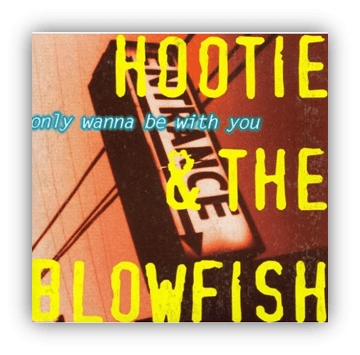
It’s “Only Wanna Be With You” by Hootie & The Blowfish!
The 90s. What a decade for stupid band names.
Butthole Surfers. Goo Goo Dolls. Crash Test Dummies. Toad The Wet Sprocket. Barenaked Ladies.
It wasn’t only the fun, novelty bands who had stupid band names. Pearl Jam may have been the most serious band in America, yet they still named themselves after semen (allegedly.)
But the award for the stupidest band name of all would have to go to Hootie & The Blowfish. They and Toad The Wet Sprocket would go out on tours together.
What a line up!
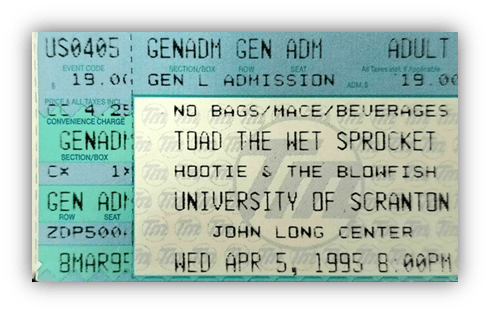
Hootie & The Blowfish would have been a stupid enough name if the lead singer of the band had actually been called Hootie. But he was not.
The lead singer of Hootie & The Blowfish was Darius Rucker, but I’m going to go and call him Hootie anyway because that’s what everyone called him back then, and I want to really capture the essence of what it was like to be alive in 1995.
In fact, there was no Hootie in Hootie & The Blowfish.
Hootie was one of the band’s friends, who wore big glasses and looked like an owl. So everyone called him Hootie. But he wasn’t in the band.
Neither was Blowfish, another one of their friends, who had big cheeks, so everyone called him The Blowfish. Hootie & The Blowfish might come across as the nicest possible rock stars, but I’m starting to wonder if they were actually really mean.
One night Darius was at a party and Hootie and The Blowfish walked in together and Darius is like, “Hey look, Hootie And The Blowfish.” And then – so Darius says – “I thought, because I’m stupid, ‘that’d be a cool name for a band.’”
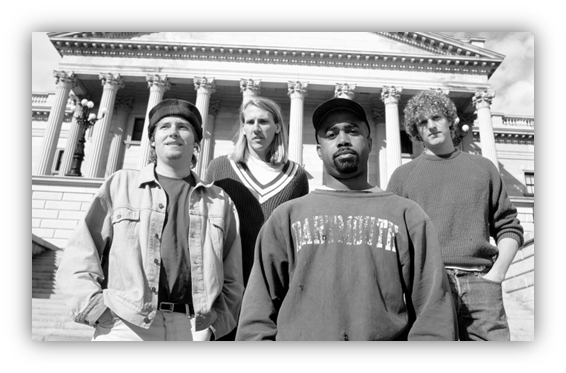
It wasn’t.
Oddly enough, as best as I can tell, although this origin story was mentioned in virtually every interview – as a way of Darius trying to explain why his name wasn’t actually Hootie – no entertainment journalist then followed it up by attempting to track down the original Hootie, to see if he did look like an owl, or the original Blowfish, to see if he looked like a blowfish.
Maybe journalists in the 90s were more respectful of people’s privacy. Or maybe they just didn’t think anyone would care. After all, this was Hootie & The Blowfish. People may have liked to say the words “Hootie & The Blowfish.” People may have bought their CDs. But people weren’t obsessed enough about them to do a deep dive into their lore.
It wasn’t easy to be a Blowfish.
Largely, but not entirely, because of their name, Hootie & The Blowfish were less of a band, and more of a punchline.
Nobody gave them any respect.
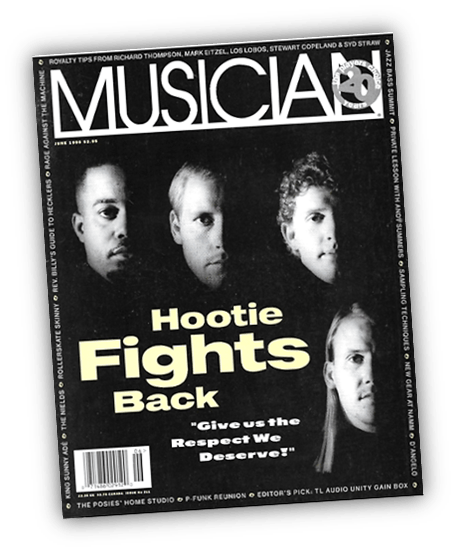
- Newspapers published articles such as “Life In The Hootie Zone: Have American Audiences Gone Insane?”
- Variety published a hard-hitting investigation into “Why Hate Hootie?”, with sources dropping phrases like “forced normalcy”, “forced optimism”, “regular guyness.”
- “Is Hootie snooty?” asked one newspaper headline “Naw, they’re just ordinary guys” – but mostly it was the name.
Curiously enough, 30% of self-professed Hootie-haters surveyed owned a copy of Cracked Rear View. A lot of people did.
Sometimes being a punchline helped. It’s possible that at least part of the reason David Letterman invited them onto his show was so he would have an excuse to say the words “Hootie & The Blowfish.”
Don’t get me wrong. David Letterman clearly genuinely liked Hootie & The Blowfish.

But he also clearly relished the opportunity to say the words “Hootie & The Blowfish.” The man’s a comedian. He knows what’ll get a laugh. As did the writers of Friends (although maybe not so much), who wrote them into an episode.
Hootie & The Blowfish didn’t seem to care that nobody thought they were cool. Not being cool was pretty much their whole brand. Spin Magazine described them as “Pearl Jam for ex-frat boys with mortgages.” Someone on RYM described them as “grillcore” – BBQ music in other words – which sadly is not a real genre.
And the Blowfish themselves said worse.
They referred to themselves a “bunch of dorks. Their lack of image was their image. Rare was the article that didn’t mention that they liked to chug beer and watch sports.
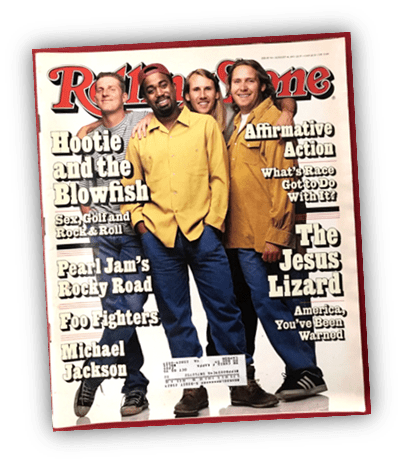
Rolling Stone went with the headline “Sex, Golf and Rock & Roll.”
Did they also enjoy fishing?
They look as though they might.
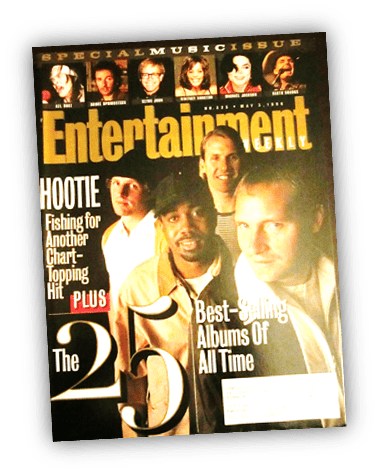
“Only Wanna Be With You” might nominally be a love song, but from the video to the whole “the Dolphins make me cry” line – about the Miami Dolphins football team, not the aquatic mammal, for although Hootie was a sensitive man he only cried about manly things – it’s basically about how much they love sport.
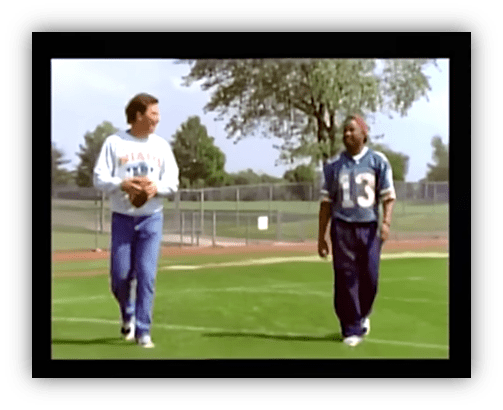
The video concept was little more than an excuse to hang out with their favourite sports heroes, including a real-life Miami Dolphin!!
That must’ve been exciting for Hootie. For Hootie loved the Miami Dolphins so much that he wore a Miami Dolphin’s cap during their Letterman performance of “Hold My Hand.” (“Hold My Hand” is a 5.)
(Side Note: I’m looking through the Dolphins’ scores in the early-to-mid 90s, and Hootie should really cheer up a little. The Dolphins weren’t that bad. They seem to have won at least slightly more than they lost.)
How had all of this happened? How had a bunch of beer chugging, sports watching, ex-frat boys become the biggest band in America?
Well, it hadn’t been easy. It was never easy to be a Blowfish.
Record companies had not been on the lookout for a Hootie.
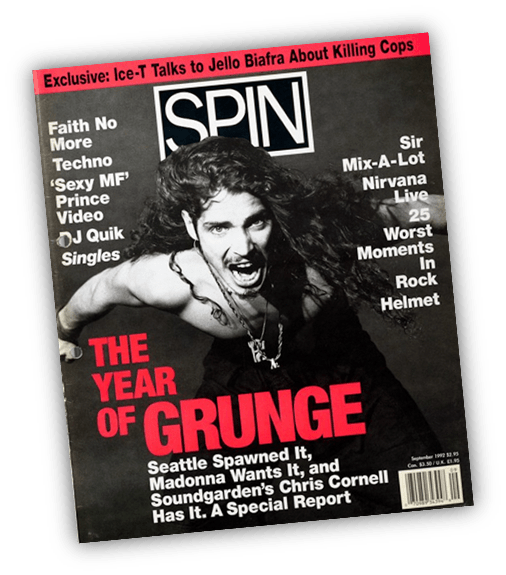
This was the mid-90s; they were too busy looking for the next Nirvana.
For the most part, this was a terrible idea. By the time record companies realize that something is happening, it’s already happened. By the time they’ve signed up the bandwagon jumpers, come up with a marketing campaign for them, and gotten the record into the stores, the consumer has moved on to something new.
Few could have guessed that something new would have been Hootie & The Blowfish.
Few could have guessed that the Next Big Thing would come from a corner of the United States that had been completely ignored in the race for the next Nirvana: “The South.”
“The South”, it turned out, had something to say.
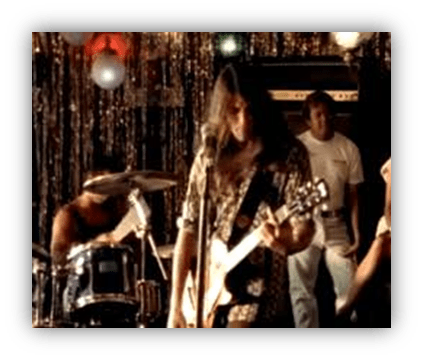
All over “The South” was an entire underground of un-cool bands that nobody wanted to sign, but who had huge cult followings amongst their fellow un-cool brethren.
We’re talking about Seven Mary Three. Collective Soul. Dave Matthews Band. All got totally ignored and had to self-release their debut albums. In the case of Hootie that album, since they seemed incapable of giving anything a decent name, was titled Kootchypop:
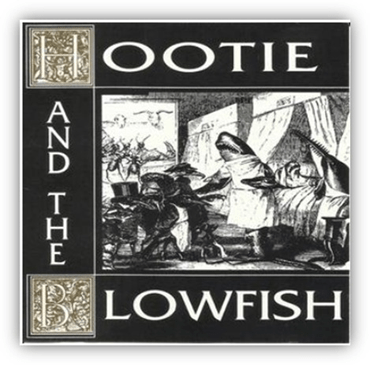
Just so they’d have something to sell to drunken party-hounds after the show.
All of them were selling a whole bunch of these self-funded CDs, through Mom & Pop stores across South Carolina, Virginia, Georgia.
Nobody cared though. Because they weren’t from Seattle.
Finally the record companies came to realize that these bands were selling heaps of self-distributed, badly recorded CDs, and that they should ignore their hangs up about what’s cool and what’s not, and sign them. And then, for their first proper release, the band would simply re-record the same songs, but this time with a proper producer.
In the case of Hootie, that producer was Don Gehman.
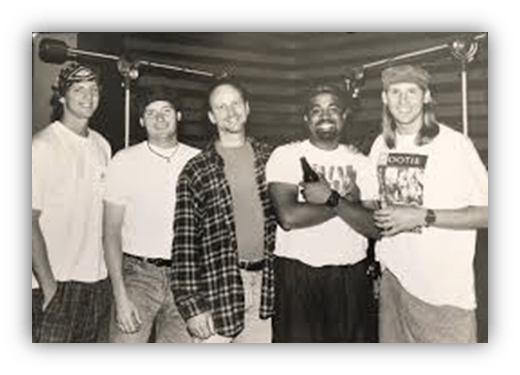
Most famous for:
- (a) producing a bunch of John Cougar classics (“Hurts So Good”, “Jack & Diane”)
- (b) producing R.E.M.’s Life’s Rich Pageant and forcing Michael Stipe to sing more intelligibly (also to write lyrics that made sense)… as an extremely radio-friendly Southern collage band, Hootie & The Blowfish split the difference between the two.
For, technically at least, Hootie & The Blowfish were a college rock band. In that they were a rock band that formed in college. Specifically in their dorm bathroom, where Hootie could be heard singing in the shower. You will not be surprised to learn that he was singing Billy Joel.
So, they started a multi-racial band as though it were nothing. Hootie was a Black man singing some of the least Black sounding music ever recorded. Some Hootie-haters would find this mystifying. This is what they were referring to when they talked about Hootie’s “forced optimism”; their playing out a fantasy that racism simply didn’t exist. “Don’t take this wrong” one source in the afore mentioned “Variety” article is quoted as saying “but I wonder about a Black guy who tries to sound like Neil Diamond.”
So, finally, having played every sports bar and frat party in South Carolina, Hootie finally got a record contract.
But the record company still thought the album had no singles – and honestly, fair enough, this isn’t the most exciting music in the world – and just figured they’d sell the album to the same crowd who bought the initial self-funded release, even though they both featured pretty much the same songs:
Songs that Hootie had been playing for five or so years.
But “Cracked Rear View” did have singles, and those singles kept on finding themselves on the radio… and racing up the charts! “Only Wanna Be With You” was the biggest. “Let Her Cry” was the best (that one does sound like a single, it’s a 7) and the album went nuts! American audiences, it appears, had gone insane.
Cracked View Mirror sold more than 20 million copies.
- That’s more than Dookie.
- That’s more than Pearl Jam’s Ten.
- It’s about as much as What’s The Story (Morning Glory).
(it’s not as much as Nevermind or Jagged Little Pill though) But whilst each of those albums sold globally, Hootie was almost exclusively an American (and Canadian… which, what with their normie niceness, makes a lot of sense) phenomenon. 22 times platinum in America, only gold in the UK.
A lot of those CDs were bought due to “Only Wanna Be With You”, an earworm so laid back that you might not even notice that one of the verses is just Hootie reciting Bob Dylan lyrics from “Idiot Wind.” Weirdly, that’s probably the weakest part of the song. Dylan’s lyrics don’t really match the melody. It just sounds like Hootie is rambling.
And I know how that sounds… it sounds as though I’m saying that Hootie was better than Dylan. But there you have it, Hootie was better than Dylan.
It’s not even as though “Idiot Wind” is one of Dylan’s most popular songs. It’s an extremely deep cut. And Hootie had been playing “Only Wanna Be With You” in sports bars and frat parties, for years. Surely, in all that time, they would have noticed that they were losing the crowd during that verse – “what’s Hootie rambling on about? Get back to singing about dolphins making you cry!!!” – and come up with something better.
But they didn’t. That would have required Hootie caring whether people thought they were cool or not. And Hootie & The Blowfish were way too laid back for that.
“Only Wanna Be With You” is a 6.
Meanwhile, in Cartoon-Ska Land…
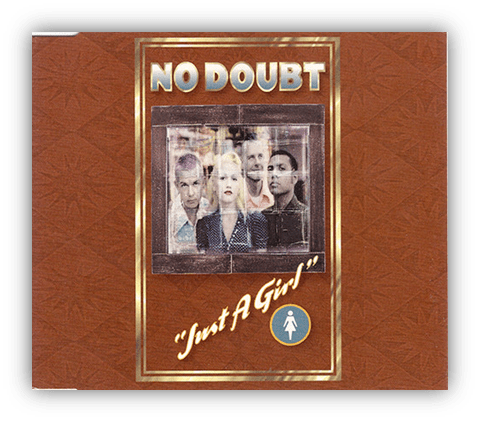
It’s Just A Girl”
by No Doubt
If buying Hootie & The Blowfish records was one way of protesting against the oppressive omnipresent nihilism of grunge or, even worse, post-grunge, a far goofier response was No Doubt, a shot of sunshine ska from California.
More specifically, from Orange County. Even more specifically, from Anaheim.
Anaheim is where Disneyland is. Makes sense, right?
- Tragic Kingdom.
- Magic Kingdom.
It’s all coming together.
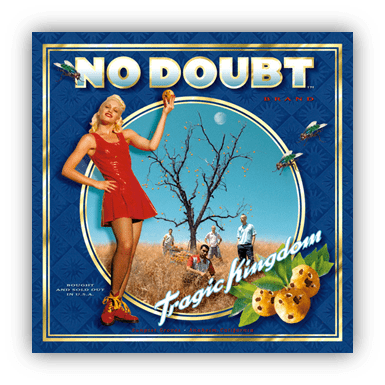
Where else could such a cartoonish addition to the alternative-rock cannon possibly originate?
The world needed No Doubt.
It needed that dose of fun and dayglo colour. It needed a feminist anthem – or is it? – sung in the voice of Betty Boop, dressed up like Tank Girl Barbie going to a rave. The world needed to be saved from the oppressive forces of Gwen’s future husband’s band. Rock radio, after all, was deep in the thralls of the Bush administration:
But the story of No Doubt, the story of “Just A Girl”, isn’t the story of Gwen and Gavin from Bush.
It’s the story of Gwen and Tony Kanal, No Doubt’s Indian-American bass-player, who Gwen had been dating for years and years… but who had recently broken up with her for being too clingy.
Awkward.
“The whole album’s about Tony” Gwen told a radio station. With Tony sitting right next to her.
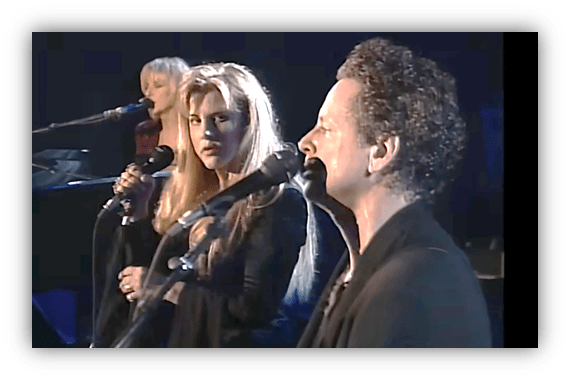
That’s almost Fleetwood Mac levels of awkward.
But the song that deals with that awkwardness is a song for next year.
“Just A Girl” was a song written about happier times, when Gwen was driving across Los Angeles to see Tony late at night. And the fact that her father wouldn’t let her. Or at least he got mad with her about it. “I mean, c’mon, I’m, like, going on 30 here!” Gwen pouted. She was 26, but the point still stands.
Gwen was the girl in a band filled with boys.
Gwen has said, on multiple occasions, that she has always been surrounded by boys: in the band, in the audience, in the mosh pit… although after “Just A Girl” that started to change.
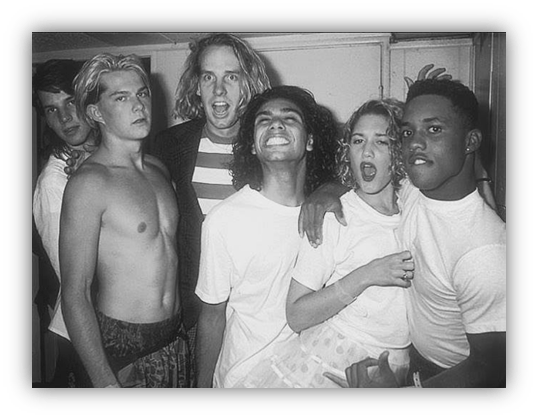
Presumedly this being-the-only-girl-surrounded-by-boys is what led to her fusion of exaggerated girliness and “oi” punk bravado.
Gwen knew what it was like to be a girl. What’s more, she knew that guys didn’t exactly get what it was like to be a girl.
“I came up with the title first, because it’s such a pathetic or sarcastic phrase. Sometimes I do find myself saying “don’t make me do that… I’m just a girl.” “I can’t carry that… I’m just a girl.”
“I’m really not the kind of person who’s a big feminist. I’m more an old fashioned kind of girl, a real girlie-girl. At the same time, being in a band for eight years with all these guys, you really see the differences between being a girl and a guy… we were on tour, playing at this college during the day, and I had to go to the bathroom, and the building across the street had the restrooms in it.
“The building is empty and dark and I’m thinking, “I’m scared. What if somebody tries to get me? Nobody would know, I’m all by myself.” I don’t think guys, unless they are going down a dark alley, and there are gangsters around, get that scared. I mean, I’m just going to the restroom and I’m getting super-paranoid.”
So Gwen wrote about the everyday hassles of being a girl. Of having to have someone go with you to the toilet. Of not being able to drive late at night.
There are advantages to being a girl, of course, as the video to “Just A Girl” makes clear.
- You have cleaner toilets if you’re a girl.
- With fake flowers on the sink.
- And bowls of fruit. And old ladies to…
…I’m not really sure what the purpose of those old ladies is.

Whereas the guy’s toilets…

Are far more difficult to figure out how to use.
“A lot of people have taken (“Just A Girl”) even further than I’ve wanted it, like some big feminist statement, which it really isn’t. It’s just random daily burdens of being a girl.”

“I Am Woman,” this ain’t.
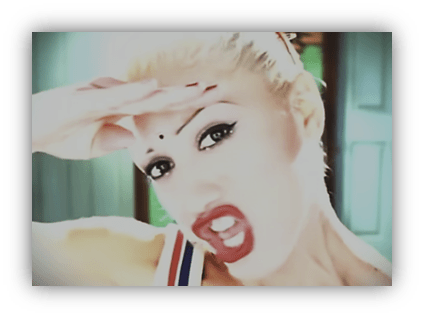
Neither is it “angry woman rock” a la Alanis, even if Gwen has had it up to “here.”
Gwen’s version of feminism can be seen in a revealing paragraph in a Spin profile:
The one with a headline seemingly designed to annoy anyone who ever felt even a little bit miffed that the phrase “riot grrl” had been co-opted by the mass media.
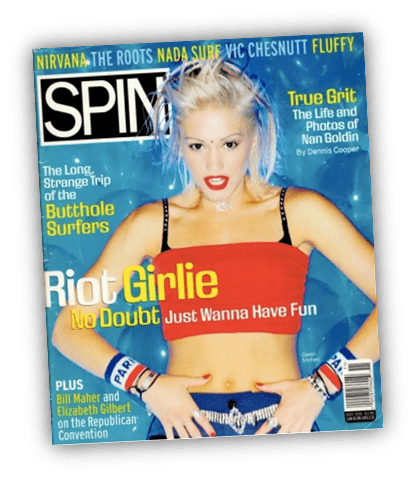
“I forced Tony to go out with me. He wasn’t even interested.”
Gwen’s a girl who makes the first move.
“But then we started going out and after the first year I was going “when are we getting married?””
She really was a traditional girl at heart. When Gwen was at school and they asked her to draw a picture of what she wanted to be when she grew up, she’d always draw a bride.
It’s also worth noting that whilst Gwen would soon become a role model and style icon for a generation, her own role model and style icon wasn’t Courtney Love or anyone like that.
It was Julie Andrews in The Sound Of Music. For her first ever performance – at a talent show her brother, and original No Doubt mastermind, Eric, cajoled her into entering – Gwen performed the ska-classic “On My Radio” whilst dressed like Fraulein Maria, specifically in the “I Have Confidence” scene.
Gwen’s love of The Sound Of Music would echo down through the ages.
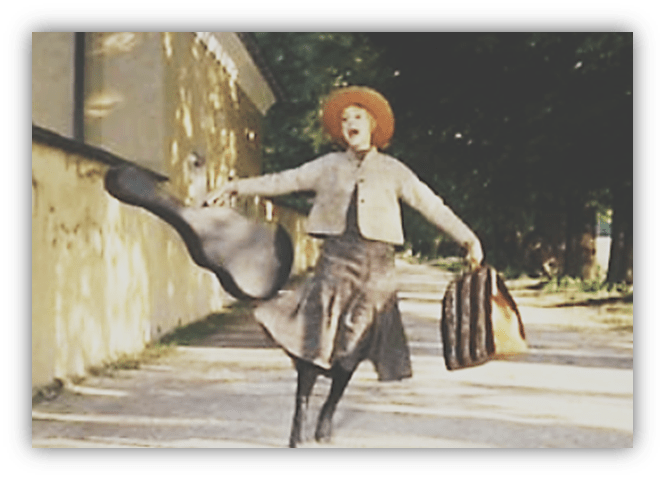
Gwen joined No Doubt soon after, starting off as backing singer for the original lead singer, John Spence, who did backflips and said “no doubt” all the time, in case you needed to know where they got the name from. But then John took his own life in 1987. That’s right, the happiest sounding band in alternative rock started with a suicide.
But they kept on going, with Gwen’s brother Eric writing the songs.
He wasn’t especially good at it, and their first album was not a hit. To be fair nobody outside of Orange County was listening to ska-punk in 1992. But within Orange Country… everyone seemed to be listening to ska-punk! It was the home of supremely stupid shit like Reel Big Fish and Sublime. Not to mention stupid shit like their own “Trapped In A Box.”
No Doubt’s first album was such a commercial disappointment – and probably would have been a critical one too if critics had known it existed – that Interscope (a) seemed to forget about them and not bother asking for a follow-up for a couple of years, and (b) when they did, brought in someone from outside the band, outside even the ska-punk scene, to produce it. They brought in Matthew Wilder. Why? Who knows? The man hadn’t been involved in a hit since “Break My Stride.”
I guess it kind of makes sense. After all, “Just A Girl” was to the rest of alternative-rock, what “Break My Stride” was to the rest of 80s pop: a freakishly dayglo aberration.
Still, the fact that “Just A Girl” was produced by the “Break My Stride” guy will never cease to amaze me. Eric was amazed as well. Or maybe disgusted and appalled are better words. Either way, he left the band, possibly in protest, or possibly because being an animator for The Simpsons seemed like a better career move at the time.

Besides, it meant that he could sneak his old band into the background of a classic Simpsons episode: Homerpalooza.
Now that Eric had left, Gwen had to come up with the songs.
She had no idea how to do that. She’d never written a song before. So she just wrote about what she knew: being a girl in an otherwise all-boy band.
Gwen Stefani was a complicated character: she described herself as a girly-girl.

She sang much of the song in a liddle-widdle voice, pouting that she was “pretty and petite.”
But she was tough.
You could tell she was tough because she did push ups in the video.

At that was at the end of the video, by which point, after all the kick-boxing she had been doing, lesser ska-punk stars might have taken a breather.
Gwen Stefani contained multitudes.
She was both this:


And this.
Gwen offered Guide To Being A Girl that inspired a generation to latch onto her as a role model, style icon and best friend. In the Gospel According To Gwen, it was possible to be tough and wear pink at the same time!

As long – and this is important – as you always showed off your midriff!
A generation of, as this article describes them. “Gwenabees.”
I’m not altogether convinced that the phrase “Gwenabees” actually caught on, but it definitely existed. It was a thing.
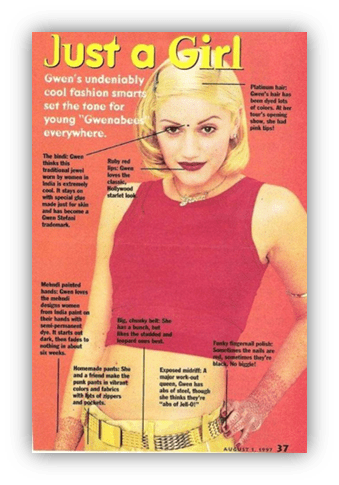
And as much as the answer to the is “Just A Girl” a feminist statement? question remains unclear – most likely answer: probably much less than you might have thought – Gwen has still left an important legacy. In simply unapologetically being herself, impervious of criticisms that she might not be feminine or feminist enough, Gwen Stefani made feminism fun.
Tweedle-dum “Just A Girl” is an 8.
Meanwhile, in Surprising Duet Couples Land…
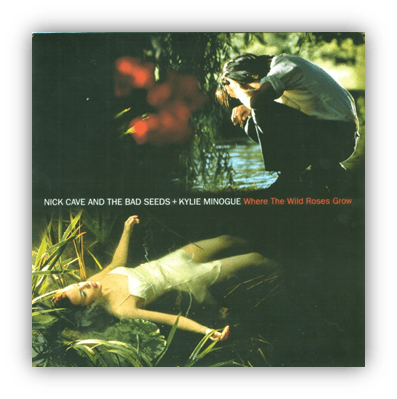
It’s “Where The Wild Roses Grow”
by Nick Cave & Kylie Minogue
Nick Cave is full of surprises.
Just when you think you’ve got a handle on him, and the way his mind works, Nick Cave says something – or these days, writes it on his Red Hand Files blog – that makes you go, “oh, that’s not what I expected at all.”
Such as that time he revealed to the world that he really liked Kylie Minogue.
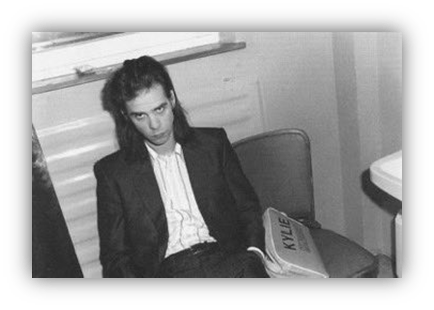
We first got a hint of this when Nick spent the early 90s carrying around a Kylie Minogue tote bag.
Sometimes, he seemed a bit more excited about it.

Nick would later spend a surprising amount of time writing, and even giving lectures, about how Kylie’s 1990 classic “Better The Devil You Know” is one of the darkest pop songs ever written. It was that song that got Nick a little obsessed about Kylie and determined to write a song for her.
But of course it would be a song about the Devil that would spark Nick’s interest.
“Where The Wild Roses Grow” is a natural extension of Nick’s reading of the “Better The Devil You Know” text. Suffice it to say that Nick Cave’s reading of “Better The Devil You Know” may not be the same as your reading of “Better The Devil You Know.”
Sometimes I wonder if Nick and I are listening to the same song… but this is how he described it, in a lecture about love songs, years later…
“When Kylie Minogue sings these words there is an innocence to her voice that makes the horror of this chilling lyric all the more compelling.”
“The idea presented within this song, dark and sinister and sad – that all love relationships are by nature abusive and that this abuse, be it physical or psychological, is welcomed and encouraged – shows how, even the most innocuous of Love Songs has the potential to hide terrible human truths.”
If that were not enough, Nick continues with…
“Like Prometheus chained to his rock, so that the eagle can eat his liver each night, Kylie becomes love’s sacrificial lamb bleating an earnest invitation to the drooling, ravenous wolf that he may devour her time and time again, all to a groovy techno beat.”
Well, at least we agree on the groovy techno beat.
So Nick did write Kylie a song, and they did record it. And the world gazed on in bafflement, as Australia’s Prince Of Darkness murdered Australia’s Princess Of Pop with a rock in his fist.
Prior to “Where The Wild Roses Grow” Nick and Kylie were icons in their own, very separate, universes.
Kylie had had four Number Ones in both Australia and the UK. Nick Cave was about as famous as a rockstar could possibly be without ever having scored a Top 40 hit, not even in Australia.
The two worlds were so separate that Kylie initially didn’t know who Nick Cave was. Her boyfriend, Michael Hutchence, kept mentioning that his friend Nick wanted to do a song with her.
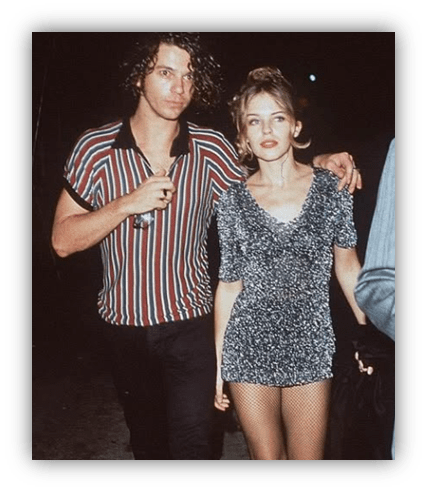
She just shrugged and said, “that’s nice, dear.”
Nick finally got Kylie’s phone number – or to be more precise, Kylie’s mother’s phone number – from Michael. So Nick has to call up Kylie’s mother, and say something along the lines of “Hi, I’m the Prince Of Darkness, I’ve written a song in which I murder your daughter”, a message which she dutifully passed on to Kylie when she got home from tour.
Kylie still wasn’t sure who Nick was, so she “speed read a biography.” She said it contained “some interesting stuff”. Quite.
Now, Nick had a legitimate reason for writing a song in which he murdered Kylie. He was working on an entire concept album about murdering people: Murder Ballads.
One might argue that a Nick Cave concept album about murder and death was a pointless endeavour, since every Nick Cave song is about death anyway. This is a guy who kickstarted his first single by his first band – Boys Next Door – with the lyrics “I’ve been contemplating suicide.” Fortunately, it turns out that it really doesn’t suit his style.
And let us not forget this masterpiece, “The Mercy Seat”, all about a criminal convicted to the electric chair, pronouncing over and over again, that he’s “not afraid to die!”
So yeah, of course when Nick first thought, “I’ve got to write a song for Kylie” his second thought would automatically be, “I guess I’m going to have to kill her.”
Nick didn’t do all the killing on Murder Ballads, though. In “Henry Lee” – not to be mistaken for Nick’s telling of “Stagger ‘Bad Motherf*cker’ Lee” – Nick’s girlfriend PJ Harvey “plugs him through and through.” That PJ Harvey is one hell of a badass.
Kylie, sadly, is not a badass. Kylie is a victim.
For Nick Cave, as his lecture quoted above demonstrates, saw Kylie as a pure and innocent creature.
What’s more, in “Where The Wild Roses Grow”, Kylie is a virgin. Kylie’s name is also, as she repeatedly informs us, Eliza Day. Aka The Wild Rose. Many online sources claim that the murder of Eliza Day is “a medieval Irish urban myth”, but short of sending a message to Nick at the Red Hands File, I can neither confirm nor deny that this is the case. Pretty much every one of these online sources simply recites Nick’s lyrics. Medieval? Huh, I doubt it dates any further back than 1995!
So, Kylie, a virgin, is terrified of Nick, and for good reason.
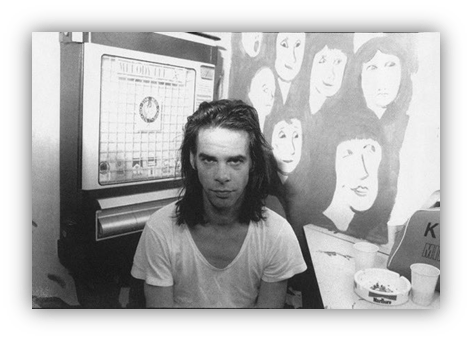
He was a scary looking guy.
But soon, her trembling subsides in his sure embrace. Despite expressing himself with the most enigmatic of prose – “will you give me your loss and your sorrow?”, “if I show you the roses, will you follow?” – she agrees to go on a date, down to the river. This, it turns out, is a bad idea. Since instead of making love to Kylie aka Eliza Day, aka The Wild Rose, as one might expect, Nick kneels above her with a rock in his fist. All beauty, it turns out, must die. Presumedly in a virginal state.
Note the themes of misogyny here. Of religious puritan fundamentalism. This is some heavy subject matter for a Pop Princess.

For Nick Cave however, it was just a Tuesday.
Kylie didn’t seem to mind too much about being dead. She couldn’t seem to keep her hands off Nick. Nick for his part described touching Kylie semi-naked body in the video as akin to a religious experience.

I wonder how Polly felt about that?
Kylie had certainly changed since her previous classic duet, “Especially For You” with Neighbours co-star and possible real-life boyfriend Jason Donovan.
It goes without saying that Nick Cave’s and Jason Donovan’s puppy-dog approach to duetting with Kylie could not be more different.
Mind you, Jason was, about this time, embarking on a new hobby himself: cocaine. A hobby that would see him end up, off his head, in a Nick Cave video of his very own: it was, inevitably, titled “Fifteen Feet Of Pure White Snow.”
Is there any Australian pop star that Nick Cave doesn’t know?


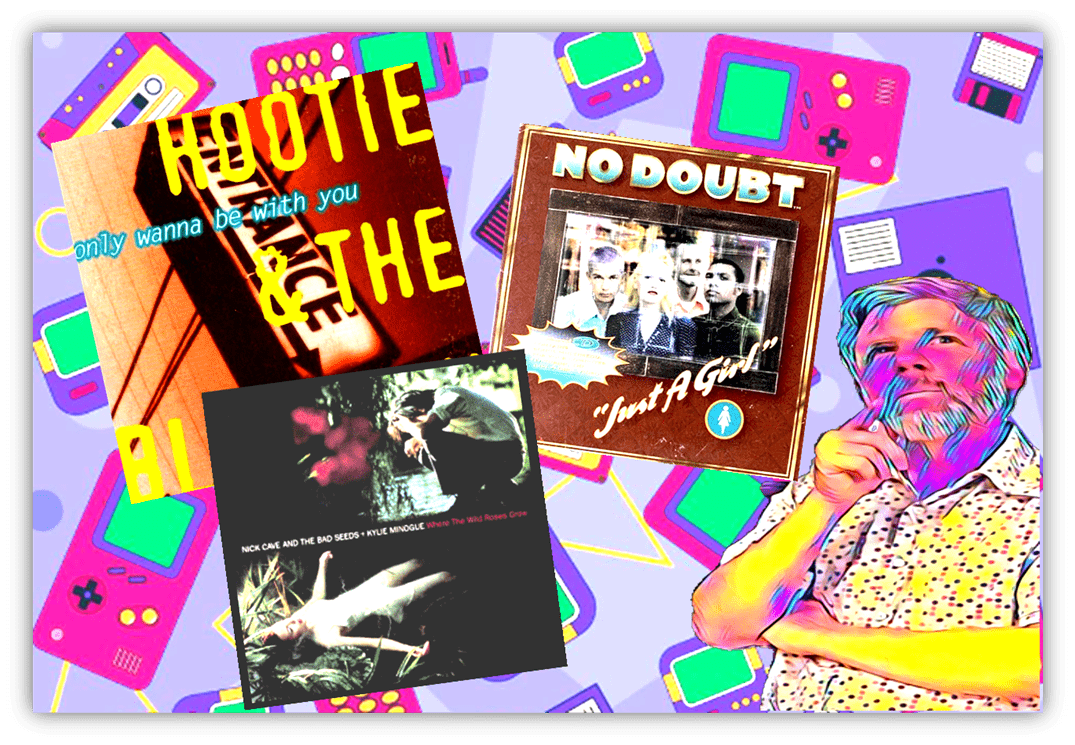
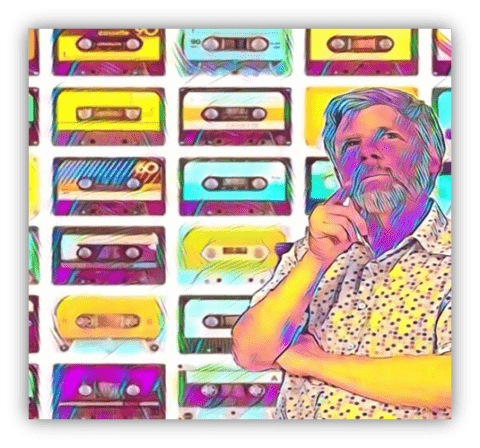

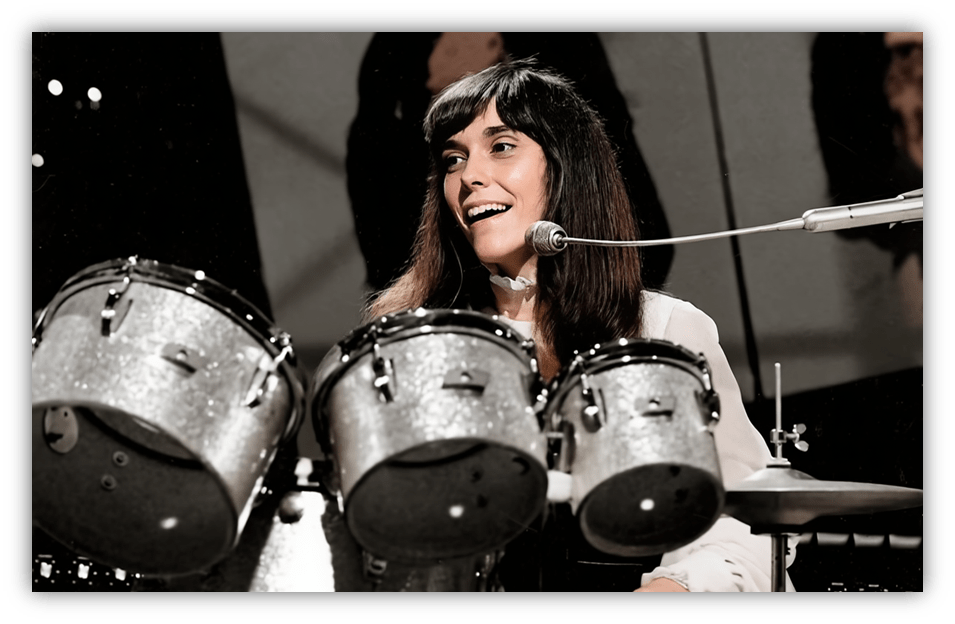
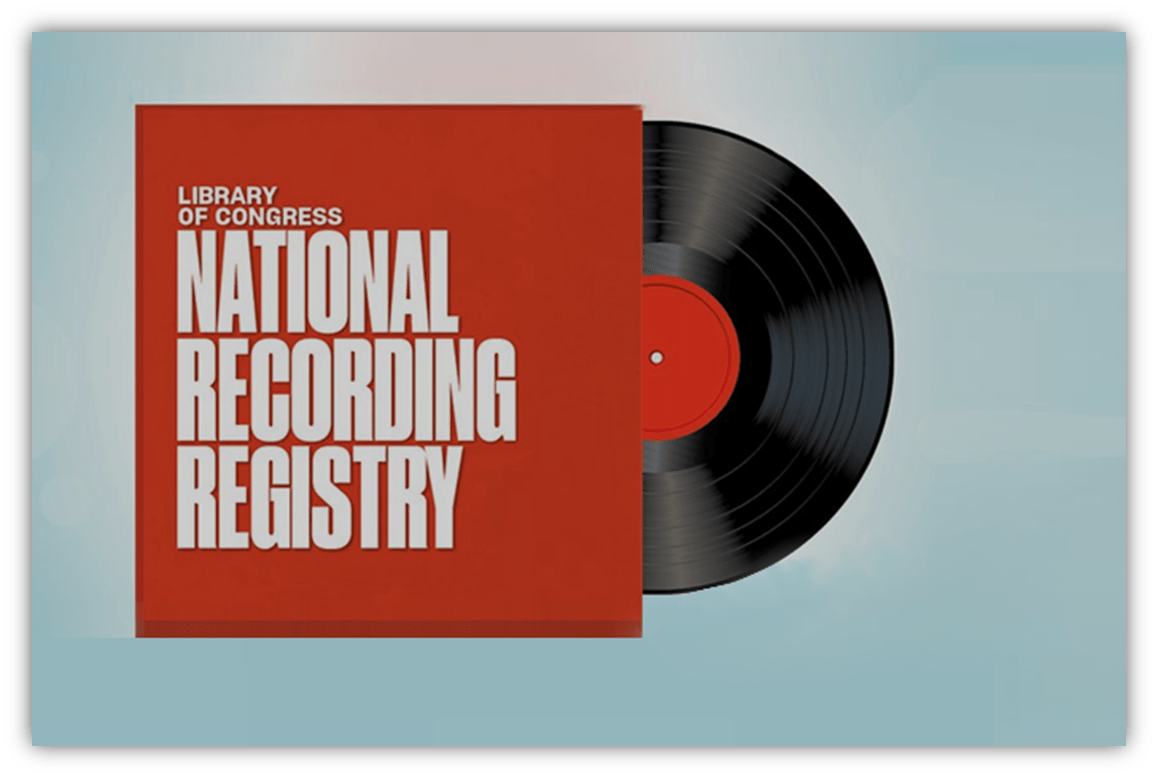


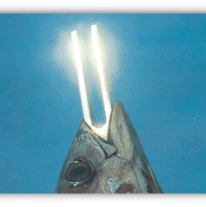
With apologies to anyone hoping for a Hootie Party Playlist… here’s the Official It’s The Hits Of October-ish 1995! Spotify Playlist, From “Just A Girl” to “Stupid Girl.”
https://open.spotify.com/playlist/4pyQvLWVQGSlL3NY1FVNkY?si=5aaca930107f40f8
On the country side of the tracks, Terri Clark has better things to do…
https://www.youtube.com/watch?v=h1ScBNkXaJk
That is a great song.
My Hootie knowledge is lacking. I’m surprised to learn Cracked Rear View did well enough to earn Gold status in the UK. Only Wanna Be With You reached the heights of #85. Though it is the only song of theirs I recognise by name. Whereas their biggest (non) hit here, at #50, was Hold My Hand. Means nothing to me.
My non scientific assumption is that their biggest impact here was as a Friends storyline. Which is in keeping with their complete anonymity as you never actually see them.
I’ll give it a 5. Blandness personified.
An accusation that could never be levelled at Nick Cave. Its been quite a journey; from terrifying gothic noise merchant in The Birthday Party to moderately terrifying leader of the Bad Seeds to intensely brooding band leader. I remember someone counting up how many deaths there were across the whole Murder Ballads album. Looking online no one can agree, it ranges from the mid 60s to 75 human. Plus one dog.
Even amongst the death toll his version of Stagger Lee is something to behold. Lloyd Price certainly wouldn’t have got to #1 with the Nick Cave take on it. Not safe for work, family gatherings or even Halloween.
The whole album is a 10.
I’m a big Ska fan, but prefer the 1st and 2nd waves to the 3rd wave that came from Southern California. It’s not bad, just not as deep. Like all that Orange County stuff, “Just A Girl” is shallower than it should have been. It’s a great name for a song, and so much more could have been done with it. Still, it helped get more women involved in Ska and that makes it a 7/10.
Nick Cave creeps me out — which is exactly what he wants — so I haven’t listened to him often. I like dark stuff but with a side of light, which not even Kylie can bring. 5/10.
Hootie & The Blowfish are so bland I had to scroll back to the top to remember who the first artist in this article was. Like “Where The Wild Roses Grow,” “Only Want To Be With You” is a 5/10 but for completely different reasons.
Nick has got less creepy with age. Though the side of light you’re looking for is still mostly absent. The latest album Wild God might be the one to do it for you, its as upbeat as the Bad Seeds have ever been. The three before that; Push The Sky Away, Skeleton Tree and Ghosteen did away with the creepy gothic story telling and the opressive foreboding of the music. They’re far more minimalist and fragile but there’s little light in them as the latter two deal with the death of his teenage son.
The two albums from his side project Grinderman from the late 00s might be worth a listen. More raucous than the Bad Seeds, a throwback to The Birthday Party musically though with a bit more polish and less chaos than them.
I don’t know enough about Nick and Kylie to have an informed opinion.
(Although, I did like her SAW record, ” I Should Be So Lucky. “ It goes into my Village People-esque bucket of songs where you can easily imagine people marching in formation as they sing the chorus.)
Anyhow, that leaves us with Hootie and Gwen, And in my mind, what they have in common: I remember at the time thinking that there’s got to be something wrong with me in that I’m not “getting it.” I chalked it up to aging out of the Top 40 and I blamed myself.
Looking back, and having liked many things post 1995, I might step back from that line of thinking.
October 1995 was a great time in my life and Hootie and No Doubt bring back a lot of happy memories – I enjoyed having some pop in my alternative radio listening!
I really thought “I Only Want To Be with You” was overplayed as much as any song from the 90s. It is objectively a good song that I should like, but I still am burnt out on it.
“Just a Girl” is a pretty fun song. I have a musical/techy buddy that figured out how to get that weird distorted/modulated keyboard sound in this song, which sounds just like the opening sounds from the Cars’ “Let’s Go”. That’s a great sound. Them borrowing it makes me like the song more.
Similar to Jack Johnson, I don’t think anybody expected Hootie and the Blowfish to blow up on the radio and sell millions of records. Cracked Rear View was reviewed in CMJ retail. “Hold My Hand” must have been on the sampler because I bought the album. In that context, my favorite music mag, the song was catchy. If I heard it on top forty radio first, I probably would’ve deemed the song as being too commercial.
In the early-nineties, those were the rules. I’m not sure when indie cred stopped being a thing.
This post also applies to Counting Crows’ August and Everything After and its lead single “Mr. Jones”. In this case, Spin reviewed it.
The problem with Hootie & The Blowfish is that “Hold My Hand” is a really good song, so I can’t totally blow them off (see also: Nickleback and “How You Remind Me”). It’s a real problem, folks.
“Only Wanna Be With You” is super-meh – the platonic defination of a 5
“Just A Girl” is really fun, but HOLY CRAP did it get overplayed to death and then beyond the grave. It’s still on a 10-year moratorium with me.
I’d heard about “Where The Wild Roses Grow” before but only heard it just now. It’s pretty cool – respect it more than I love it.